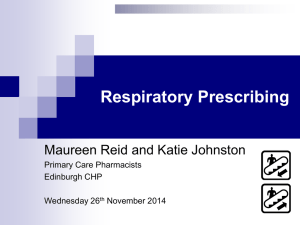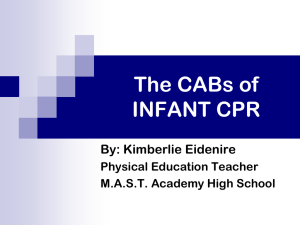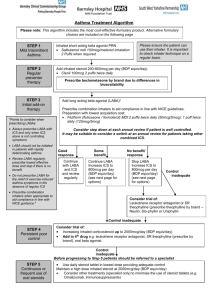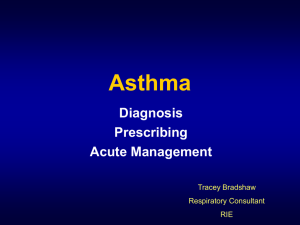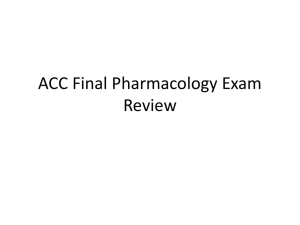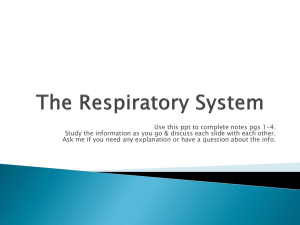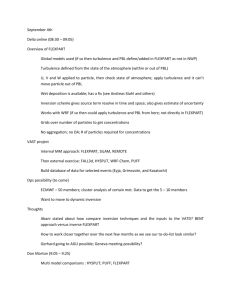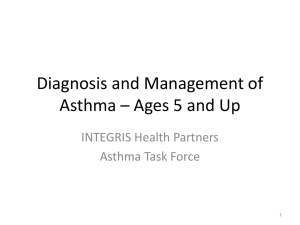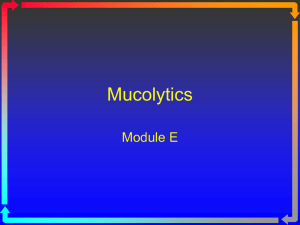Pharmacology - Respiratory Therapy Files
advertisement
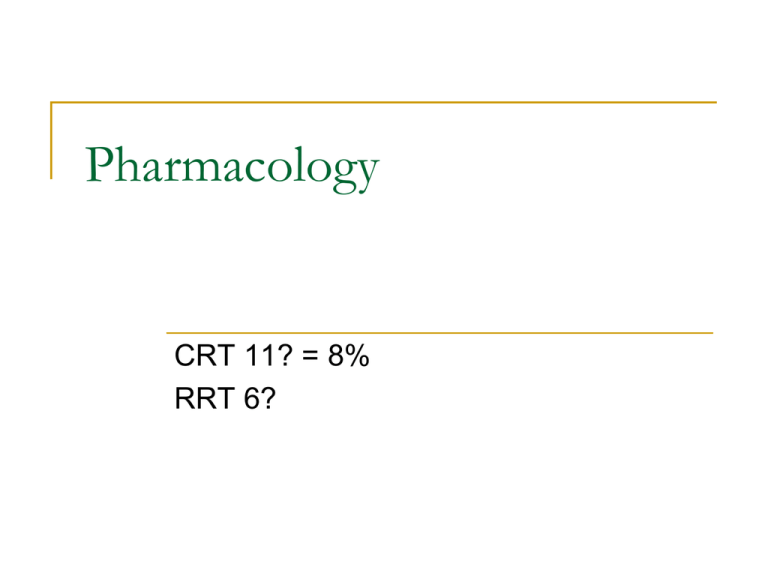
Pharmacology CRT 11? = 8% RRT 6? A 30-year-old patient presents to the asthma clinic with a 2-week history of daily wheezing and nightly awakenings with shortness of breath. The patient is using Primatene Mist five times daily and fluticasone propionate (Flovent) 110 MDI occassionally at night. How should the therapist counsel the patient regarding disease management? I. Discontinue Primatene Mist II. Use fluticasone propionate (Flovent) 110 MDI, 2 puffs twice daily. III. Use salmeterol (Serevent) dry powder inhaler, 1 dose twice daily. IV. Use fluticasone propionate/salmeterol (Advair) 100/50 dry powder inhaler, one dose daily. A. B. C. D. I, II, and III only I, II, and IV only I, III, and IV only II, III, and IV only A 30-year-old patient presents to the asthma clinic with a 2-week history of daily wheezing and nightly awakenings with shortness of breath. The patient is using Primatene Mist five times daily and fluticasone propionate (Flovent) 110 MDI occassionally at night. How should the therapist counsel the patient regarding disease management? I. Discontinue Primatene Mist II. Use fluticasone propionate (Flovent) 110 MDI, 2 puffs twice daily. III. Use salmeterol (Serevent) dry powder inhaler, 1 dose twice daily. IV. Use fluticasone propionate/salmeterol (Advair) 100/50 dry powder inhaler, one dose daily. A. B. C. D. I, II, and III only I, II, and IV only I, III, and IV only II, III, and IV only Which of the following is associated with the administration of aerosolized pentamidine isethionate (NebuPent)? A.tachycardia B.bradycardia C.bronchospasm D.hypotension Which of the following is associated with the administration of aerosolized pentamidine isethionate (NebuPent)? A.tachycardia B.bradycardia C.bronchospasm D.hypotension An increase in a patient's heart rate during aerosolized bronchodilator therapy is primarily a result of which of the following drug effects? A.alpha only B.beta 1 only C.beta 2 only D.beta 1 and beta 2 only An increase in a patient's heart rate during aerosolized bronchodilator therapy is primarily a result of which of the following drug effects? A.alpha only B.beta 1 only C.beta 2 only D.beta 1 and beta 2 only Which of the following devices are most commonly used to deliver aerosols by the inhalation route? I. Dry powder inhaler II. Metered dose inhaler III. Small-volume nebulizer IV.Slip-stream nebulizer A. I and III B. II and IV C. I, II, and III D. I, II, III, and IV Which of the following devices are most commonly used to deliver aerosols by the inhalation route? I. Dry powder inhaler II. Metered dose inhaler III. Small-volume nebulizer IV.Slip-stream nebulizer A. I and III B. II and IV C. I, II, and III D. I, II, III, and IV Which of the following are the largest single group of drugs among aerosolized agents used for inhalation? A. Inhaled corticosteroids B. Adrenergic bronchodilators C. Mucus-controlling agents D. Anticholinergic bronchodilators Which of the following are the largest single group of drugs among aerosolized agents used for inhalation? A. Inhaled corticosteroids B. Adrenergic bronchodilators C. Mucus-controlling agents D. Anticholinergic bronchodilators Which of the following is an indication for use of an adrenergic bronchodilator? A.Treatment of excessive, viscous mucus secretions B.Antiinflammatory treatment of mild to moderate persistent asthma C.Treatment of reversible airflow obstruction D.Prophylactic management of asthma Which of the following is an indication for use of an adrenergic bronchodilator? A.Treatment of excessive, viscous mucus secretions B.Antiinflammatory treatment of mild to moderate persistent asthma C.Treatment of reversible airflow obstruction D.Prophylactic management of asthma Proventil and Ventolin are brand names for which of the following beta-adrenergic bronchodilators? A. Albuterol B. Isoetharine C. Terbutaline D. Metaproterenol Proventil and Ventolin are brand names for which of the following beta-adrenergic bronchodilators? A. Albuterol B. Isoetharine C. Terbutaline D. Metaproterenol An MDI of Salmeterol delivers which of the following? A. 131 mg/puff B. 90 mg/puff C. 65 mg/puff D. 25 mg/puff An MDI of Salmeterol delivers which of the following? A. 131 mg/puff B. 90 mg/puff C. 65 mg/puff D. 25 mg/puff Which of the following short-acting catecholamines are used for their strong alpha1 vasoconstricting effects to reduce swelling in the nose and larynx and to control bleeding during bronchoscopic biopsy? A. Isoproterenol B. Isoetharine C. Dobutamine D. Racemic epinephrine Which of the following short-acting catecholamines are used for their strong alpha1 vasoconstricting effects to reduce swelling in the nose and larynx and to control bleeding during bronchoscopic biopsy? A. Isoproterenol B. Isoetharine C. Dobutamine D. Racemic epinephrine Which of the following are side effects of newer, more beta2-selective bronchodilators? A. Tremor B. Insomnia C. Nervousness D. All the above Which of the following are side effects of newer, more beta2-selective bronchodilators? A. Tremor B. Insomnia C. Nervousness D. All the above What are some potential adverse effects with use of adrenergic bronchodilators? I. Hypokalemia II. Dizziness III. Worsening ventilation/perfusion ratio (V/Q) IV.Bradycardia A. I and IV only B. II and III only C. I, II, and III D. I, II, III, and IV What are some potential adverse effects with use of adrenergic bronchodilators? I. Hypokalemia II. Dizziness III. Worsening ventilation/perfusion ratio (V/Q) IV.Bradycardia A. I and IV only B. II and III only C. I, II, and III D. I, II, III, and IV Which of the following are assessment features for evaluating patient response to bronchodilator therapy? I. Reversibility of airflow obstruction II. Changes in flow rates using a peak flow meter or portable spirometry III. Vital-sign changes (e.g., blood pressure, pulse rate) IV. Changes in ventilation and oxygenation by arterial blood gas or pulse oximeter V. The patient's subjective reaction to treatment A. B. C. D. II, III, and IV II, III, and V I, II, III, and V I, II, III, IV, and V Which of the following are assessment features for evaluating patient response to bronchodilator therapy? I. Reversibility of airflow obstruction II. Changes in flow rates using a peak flow meter or portable spirometry III. Vital-sign changes (e.g., blood pressure, pulse rate) IV. Changes in ventilation and oxygenation by arterial blood gas or pulse oximeter V. The patient's subjective reaction to treatment A. B. C. D. II, III, and IV II, III, and V I, II, III, and V I, II, III, IV, and V What amount of Ipratropium bromide (Atrovent) is delivered by MDI? A. 10 mg/puff B. 15 mg/puff C. 18 mg/puff D. 90 mg/puff What amount of Ipratropium bromide (Atrovent) is delivered by MDI? A. 10 mg/puff B. 15 mg/puff C. 18 mg/puff D. 90 mg/puff What is the dosage for Ipratropium bromide (Atrovent)? A. 2 puffs qid B. 2 puffs tid C. 2 puffs bid D. 2 puffs q12h What is the dosage for Ipratropium bromide (Atrovent)? A. 2 puffs qid B. 2 puffs tid C. 2 puffs bid D. 2 puffs q12h What are some common side effects seen with Ipratropium bromide (Atrovent)? A. Tachycardia B. Blood pressure increase C. Cough and dry mouth D. Tolerance What are some common side effects seen with Ipratropium bromide (Atrovent)? A. Tachycardia B. Blood pressure increase C. Cough and dry mouth D. Tolerance Which of the following are indications for use of acetylcysteine (Mucomyst)? I. Treatment of acetaminophen overdose II. Treatment of excessive, viscous mucus secretions III. Treatment of aspirin overdose IV.Treatment of purulent mucus secretions by breaking up DNA A. I and II only B. II and IV only C. I, II, and III D. I, II, III, and IV Which of the following are indications for use of acetylcysteine (Mucomyst)? I. Treatment of acetaminophen overdose II. Treatment of excessive, viscous mucus secretions III. Treatment of aspirin overdose IV.Treatment of purulent mucus secretions by breaking up DNA A. I and II only B. II and IV only C. I, II, and III D. I, II, III, and IV Acetylcysteine (Mucomyst) lowers the viscosity of mucus by means of which of the following? A.Breaking down DNA B.Increasing the osmolarity of the mucus and pulling water into it C.Changing the pH of the mucus, causing it to break down D.Substituting its sulfhydryl group for disulfide bonds and breaking a portion of the bond forming the gel structure Acetylcysteine (Mucomyst) lowers the viscosity of mucus by means of which of the following? A.Breaking down DNA B.Increasing the osmolarity of the mucus and pulling water into it C.Changing the pH of the mucus, causing it to break down D.Substituting its sulfhydryl group for disulfide bonds and breaking a portion of the bond forming the gel structure Which of the following should be assessed when delivering acetylcysteine (Mucomyst)? I. Presence of adverse effects that require treatment to be discontinued II. Monitoring peak flow changes III. Monitoring color, consistency, and amount of sputum IV. Monitoring for presence of hydrogen sulfide (a rotten egg odor), which means that the acetylcysteine (Mucomyst) is no longer active A. B. C. D. I and III only I, II, and III II, III, and IV I, II, III, and IV Which of the following should be assessed when delivering acetylcysteine (Mucomyst)? I. Presence of adverse effects that require treatment to be discontinued II. Monitoring peak flow changes III. Monitoring color, consistency, and amount of sputum IV. Monitoring for presence of hydrogen sulfide (a rotten egg odor), which means that the acetylcysteine (Mucomyst) is no longer active A. B. C. D. I and III only I, II, and III II, III, and IV I, II, III, and IV Which of the following are true regarding glucocorticoids? I. They work through activation of intracellular receptors. II. Relief is immediate. III. Daily compliance is essential to controlling inflammation in asthma. IV. Taken intranasally they can control allergic and nonallergic rhinitis. A. I, II, and III B. I, III, and IV C. II, III, and IV D. I, II, III, and IV Which of the following are true regarding glucocorticoids? I. They work through activation of intracellular receptors. II. Relief is immediate. III. Daily compliance is essential to controlling inflammation in asthma. IV. Taken intranasally they can control allergic and nonallergic rhinitis. A. I, II, and III B. I, III, and IV C. II, III, and IV D. I, II, III, and IV How does cromolyn sodium work? A.Producing antiinflammatory enzymes within cells B.Inhibiting degranulation of mast cells C.Preventing arachidonic acid formation from activation of mast cell membrane phospholipase A2 D.Leukotriene inhibition How does cromolyn sodium work? A.Producing antiinflammatory enzymes within cells B.Inhibiting degranulation of mast cells C.Preventing arachidonic acid formation from activation of mast cell membrane phospholipase A2 D.Leukotriene inhibition Which of the following is true about the use of Ribavirin? I. It is used as an antiviral agent against influenza. II. It is delivered by a SPAG unit. III. Adverse effects include skin rash, conjunctivitis, and eyelid erythema. IV.It can occlude endotracheal-tube and ventilator exhalation valves. A. I, and II only B. III and IV only C. II, III, and IV D. I, II, III, and IV Which of the following is true about the use of Ribavirin? I. It is used as an antiviral agent against influenza. II. It is delivered by a SPAG unit. III. Adverse effects include skin rash, conjunctivitis, and eyelid erythema. IV.It can occlude endotracheal-tube and ventilator exhalation valves. A. I, and II only B. III and IV only C. II, III, and IV D. I, II, III, and IV
